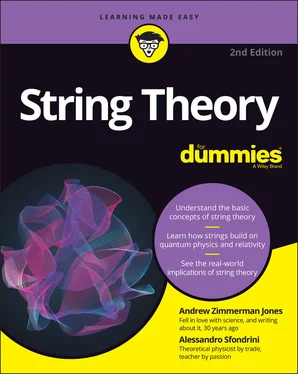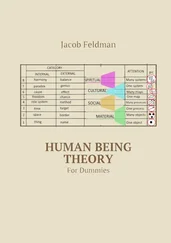No matter how complex modern physics concepts get, they have their roots in classical ideas. To understand the revolutions leading up to string theory, you need to first understand these basic ideas. You’ll then be able to understand how string theory recovers and generalizes them.
In this chapter, we present some physics concepts that you need to be familiar with to understand string theory. First, we discuss three fundamental concepts in physics: matter, energy, and how they interact. Next, we explain waves and vibrations, which are crucial to understanding stringy behavior. Gravity is also key, so Sir Isaac Newton’s important discoveries come next. Finally, we give a brief overview of electromagnetic radiation, an important aspect of physics that led directly into the discovery of both relativity and quantum physics — the two theories that together gave birth to modern string theory!
This Crazy Little Thing Called Physics
Physics is the study of matter and its interactions. Physics tries to understand the behavior of physical systems from the most fundamental laws that we can achieve. String theory could provide these most fundamental laws and explain all of the universe in an elegant way.
One other key principle of physics is the idea that many of the laws that work in one location also work in another location — a principle known as symmetry (we cover this in more detail later in this section and also in Chapter 4). The connection between physics in different locations is just one sort of symmetry, allowing physics concepts to be related to each other. Science has progressed by taking diverse concepts and unifying them into cohesive physical laws.
That’s a very broad definition of physics, but then physics is the broadest science. Because everything you see, hear, smell, touch, taste, or in any way interact with is made of matter and interacts according to some sort of rules, that means physics is literally the study of anything that happens. In a way, chemistry and all the other sciences are approximations of the fundamental laws of physics.
 Even if string theory (or some other “theory of everything”) were to be verified experimentally, there would still be a need for other sciences. Trying to figure out every single physical system from string theory would be as absurd as trying to study the weather by analyzing every single atom in the atmosphere.
Even if string theory (or some other “theory of everything”) were to be verified experimentally, there would still be a need for other sciences. Trying to figure out every single physical system from string theory would be as absurd as trying to study the weather by analyzing every single atom in the atmosphere.
No laughing matter: What we’re made of
One of the traits of matter (the “stuff” that everything is made of) is that it requires force to do something. (There are some exceptions to this, but as a rule, a force is any influence that produces a change, or prevents a change, in a physical quantity.) Mass is the property that allows matter to resist a change in motion (in other words, the ability to resist force) . Another key trait of matter is that it’s conserved, meaning it can’t be created or destroyed but can only change forms. (Einstein’s theory of relativity showed this wasn’t entirely true, as you see in Chapter 6.)
Without matter, the universe would be a pretty boring place. Matter is all around you. The book you’re reading, as you lean back comfortably in your matter-laden chair, is made of matter. You yourself are made of matter. But what, exactly, is this stuff called matter?
A matter of inertia, and a matter of the utmost gravity
When we think of any type of matter, a couple of unrelated images come up. First, we cannot go “through” matter: We cannot move through walls, and even wading in water, we encounter resistance. Second, all matter falls down, thanks to gravity.
Newton’s key insight was to understand that these are truly fundamental properties of all matter. The first property can be summarized by saying that all matter resists any attempt to put it into motion (we explain this in more detail later in this chapter in “ Force, mass, and acceleration: Putting objects into motion”). This is called inertia, and the degree to which an object resists this change is its inertial mass .
The second property is that all matter is subject to the force of gravity. In fact, in Newton’s law of universal gravitation, the mass of an object plays the role of the charge of the gravitational attraction, just like the electric charge does for the electric force. Not that Newton could have known this: The electric force was discovered by Charles-Augustin de Coulomb a century after Newton. To emphasize that the mass is the source of the gravitational attraction, we talk of gravitational mass .
If you think that using two different words — inertial and gravitational — to refer to mass is a little odd, you are spot on: It turns out that the two concepts of mass are one and the same! This is absolutely not obvious at first look. It wasn’t until the early 1900s that a Hungarian gentleman named Loránd Eötvös came up with a clever experiment that convinced people that this was the right way to think about Newton’s discovery. This fact is a crucial ingredient in Einstein’s general relativity theory and in string theory.
Scientists discover that mass can’t be destroyed
Antoine-Laurent Lavoisier’s work in the 18th century provided physics with another great insight into matter. Lavoisier and his wife, Marie Anne, performed extensive experiments that indicated matter can’t be destroyed; it merely changes from one form to another. This principle is called the conservation of mass.
This isn’t an obvious property. If you burn a log, when you look at the pile of ash, it certainly looks like you have a lot less matter than you started with. But, indeed, Lavoisier found that if you’re extremely careful that you don’t misplace any of the pieces — including the pieces that normally float away during the act of burning — you end up with as much mass at the end of the burning as you started with.
Over and over again, Lavoisier showed this unexpected trait of matter to be the case, so much so that we now take it for granted as a familiar part of our universe. Water may boil from liquid into gas, but the particles of water continue to exist and can, if care is taken, be reconstituted back into liquid. Matter can change form, but can’t be destroyed This picture becomes more complicated when one starts looking at chemical and nuclear reactions, when one can trade a tiny amount of mass for quite a lot of energy. But this was not yet understood until well after Lavoiser’s time.
As the study of matter progresses through time, things grow stranger instead of more familiar. In Chapter 8, we discuss the modern understanding of matter, which is that we are composed mostly of tiny particles that are linked together with invisible forces across vast (from their scale) empty distances. In fact, as string theory suggests, it’s possible that even those tiny particles aren’t really there — at least not in the way we normally picture them.
Add a little energy: Why stuff happens
The matter in our universe would never do anything interesting if it weren’t for the addition of energy. There would be no change from hot to cold or from fast to slow. Energy is also conserved, as scientists discovered throughout the 1800s as they explored the laws of thermodynamics, but the story of energy’s conservation is more elusive than that of matter. You can see matter, but tracking energy proves to be trickier.
Kinetic energy is the energy involved when an object is in motion. Potential energy is the energy contained within an object, waiting to be turned into kinetic energy. It turns out that the total energy — kinetic energy plus potential energy — is conserved any time a physical system undergoes a change.
Читать дальше

 Even if string theory (or some other “theory of everything”) were to be verified experimentally, there would still be a need for other sciences. Trying to figure out every single physical system from string theory would be as absurd as trying to study the weather by analyzing every single atom in the atmosphere.
Even if string theory (or some other “theory of everything”) were to be verified experimentally, there would still be a need for other sciences. Trying to figure out every single physical system from string theory would be as absurd as trying to study the weather by analyzing every single atom in the atmosphere.










